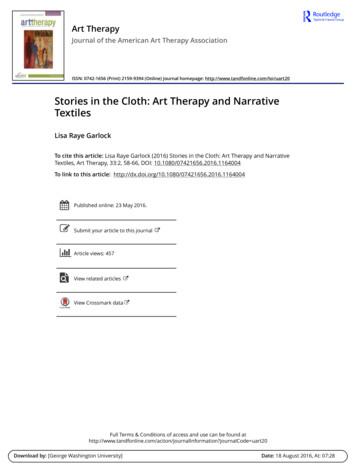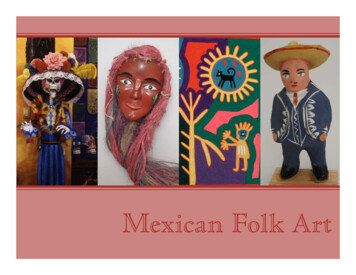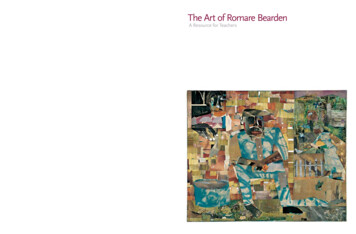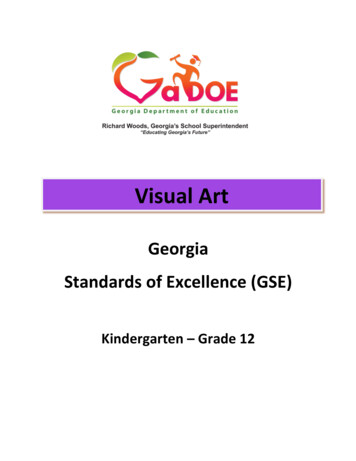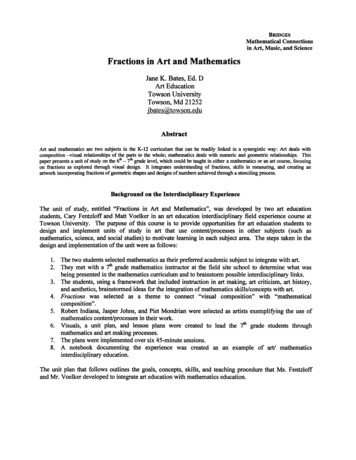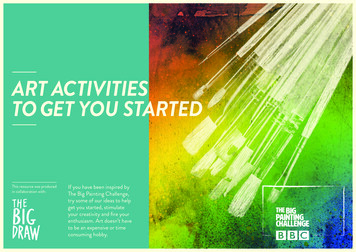
Transcription
ART ACTIVITIESTO GET YOU STARTEDThis resource was producedin collaboration with:If you have been inspired byThe Big Painting Challenge,try some of our ideas to helpget you started, stimulateyour creativity and fire yourenthusiasm. Art doesn’t haveto be an expensive or timeconsuming hobby.
STARTA SKETCHBOOKUsing a book to record whatyou see and experience willinspire you creatively. Keep itwith you and use it for quicksketches, saving interestingimages, recording words youlike or taking rubbings ofdifferent surfaces – anythingthat gives you inspiration.Tips for your sketch book: Make sure the size andpaper suits you. Paper ismeasured by gsm (grams persquare metre), the higherthe number the heavier thepaper. Heavier paperis better for painting. Make your own book byfolding any spare paper inhalf. Make a cover out ofscrap card. Use an elasticband to hold pages together.This will allow you to add orremove pages. Using differentpaper can help creativityso try a mix of plain, lined,coloured or patterned paper. Try using an existing booksuch as a picture book. Stickdrawings/sketches into it andwork around any existing textor images.
DRAWINGWITH PENCILPencils are graded, each grade givingdifferent effects. An HB pencil gives youa hard, strong line. A 2B pencil gives yousofter lines. The higher the grade of aB pencil the softer it is. Experiment withdifferent grades by drawing lines andpatterns to create tones.Also test on different surfaces to seehow they affect the results. Draw simplegeometric shapes such as circles or cubesand use assorted pencils to create 3Deffects. Use a viewfinder (simple framemade from cardboard) to pick out specificareas of an object – start by trying thistechnique on a leaf to focus on tone,shade and pattern.
PAINTINGThere are lots of differenttypes of paint including oil,gouache, acrylic, ready-mixedliquid paint, poster paint andwatercolour. Poster paintand watercolour are good forbeginners as they are cheap,easy to use and portable.Watercolours come in blocksor tubes and need to bemixed before use. An old tray,ceramic tile, or a plate are goodfor mixing. An assortment ofbrushes with different widthsis useful and an old sponge isgood for applying paint fortextured effects.Experiment usingthese techniques: Paint with coffee: to experiment withdifferent washes and tones try paintingwith coffee and water. The more wateryou add the lighter the colour. Tryapplying this to a sketch of a dark glassbottle as an example. Effects of salt: using watercolour, paint acolour wash over the paper. Don’t get ittoo wet. Sprinkle a little salt or dishwashersalt onto it and watch what happens.When dry, brush the salt away. Plastic wrap: paint an area of colour andwhile the paint is still wet, place the plasticwrap onto it. Carefully push the wrapto create different lines and textures.Remove when the paint is dry. Try tissuepaper for similar effects. Wax resist: draw an image using a candleor wax crayon, making sure to press downhard. Use a wash of paint over the top.The wax resists the paint so the imagestands out.
ACTIVITIESYou will need: card or scrapwood, HB pencil, soft pencils(2B and higher), lining paperor A2 paper, tapeUSING LINESYou will need: fine line/felttip pen (dark colour), water,brush, paperChoose a small object to draw.Look for something withinteresting lines and pattern,perhaps a leaf or piece of wood.Sketch it with an HB pencildrawing lines only, withoutshading. Using the pen go overthe outlines and details. Whilstthe lines are still wet, use a finebrush to apply clean water overthe lines. This will create a bleedeffect.DRAWINGOUTSIDEME, MYSELFAND IYou will need: camera phone ordigital camera, PC and printer,glue stick, paper, colouredpencils, HB pencilTake a photo of yourself,process and print on A4 or A3paper. Cut or tear it in halfvertically. Glue one side to asheet of paper and draw theother side by observing thediscarded half. Try to match thecolours and the textural detailand tonal shades.Make a drawing board (fromcard or scrap wood) and tapeyour paper onto it. Find a treeto draw. Trees are strong shapesthat are good to observe anddraw. Use the HB pencil tosketch the shapes. Start withthe trunk and main branches,then add more detail. Draw big.Take your drawing home anddevelop it further adding tonewith softer pencils. You couldalso try this with charcoal andwhite chalk – messier but fun.NATURALCOLLAGEYou will need: twigs, leavesand foliage, stones, pebblesCollect as much naturalmaterial as you can. Use oneof the drawings from yoursketch book as a starting pointto create a natural collage onthe ground. Create outlines,then add detail. Photographit step by step to make a stopframe animation.
ARTACTIVITIESFOR CHILDRENBODY ARTYou will need: large piece ofpaper, pencils, an old sponge,ready–mixed liquid paints in potsAsk the child to lie on thepaper and get a partner todraw around their body with apencil. Dip the sponge into thepots of paint and apply ontothe outline. Experiment withthe sponge to create differenttextures and colours.NEGATIVESHAPESYou will need: paper, children’sscissors, watercolours, broadbrushes, gummed paper, spongeCut different shapes from thegummed paper, dampen it witha sponge and stick onto a sheetof paper. Use watercolours tocreate different colour washesaround the shapes, allowingthe colours to bleed into eachother. Leave to dry then peeloff the shapes.
types of paint including oil, gouache, acrylic, ready-mixed liquid paint, poster paint and watercolour. Poster paint and watercolour are good for beginners as they are cheap, easy to use and portable. Watercolours come in blocks or tubes and need to be mixed before use. An old tray, ceramic tile, or a plate are good for mixing. An assortment of







